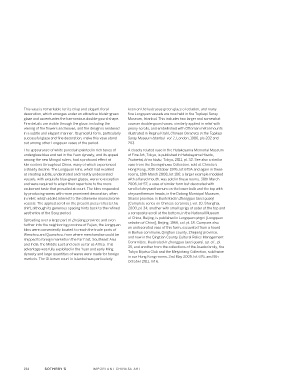Page 196 - Important Chinese Art Sothebys March 2019
P. 196
this vase is remarkable for its crisp and elegant floral keen on the lustruous green glaze of celadon, and many
decoration, which emerges under an attractive bluish-green fine Longquan vessels are now held in the topkapi saray
glaze and accentuates the harmonious double-gourd shape. museum, Istanbul. this includes two larger and somewhat
Fine details are visible through the glaze, including the coarser double-gourd vases, similarly applied in relief with
veining of the flowers and leaves, and the design is rendered peony scrolls, and embellished with ottoman metal mounts
in a subtle and elegant manner. Its graceful form, particularly illustrated in regina Krahl, Chinese Ceramics in the Topkapi
successful glaze and fine decoration, make this vase stand Saray Museum Istanbul vol. 1, London, 1986, pls 202 and
out among other Longquan vases of the period. 203.
the appearance of white porcelain painted in rich tones of a closely related vase in the hatakeyama memorial museum
underglaze blue and red in the Yuan dynasty, and its appeal of Fine art, tokyo, is published in hatakeyama hisato,
among the new mongol rulers, had a profound effect at Tsutaetai, bi no kioku, tokyo, 2011, pl. 32. see also a similar
kiln centers throughout China, many of which experienced vase from the Dexingshuwu Collection, sold at Christie’s
a steady decline. the Longquan kilns, which had excelled hong Kong, 30th october 1995, lot 679a and again in these
at creating subtle, understated and mostly undecorated rooms, 18th march 2008, lot 106; a larger example modeled
vessels, with exquisite blue-green glazes, were no exception with a flared mouth, was sold in these rooms, 30th march
and were required to adapt their repertoire to the more 2006, lot 57; a vase of similar form but decorated with
exuberant taste that prevailed at court. the kilns responded scroll of chrysanthemum on the lower bulb and the top with
by producing wares with more prominent decoration, often chrysanthemum heads, in the Datong municipal museum,
in relief, which added interest to the otherwise monochrome shanxi province, is illustrated in Zhongguo taoci quanji
vessels. the applied scroll on the present piece reflects this [Complete series on Chinese ceramics], vol. 10, shanghai,
shift, although its generous spacing hints back to the refined 2000, pl. 34; another with small sprigs of aster at the top and
aesthetics of the song period. a composite scroll at the bottom, in the national museum
of China, Beijing, is published in Longquan qingci [Longquan
spreading over a large part of Zhejiang province and even
further into the neighboring province of Fujian, the Longquan celadon of China], Beijing, 1966, col. pl. 18. Compare also
an undecorated vase of this form, excavated from a hoard
kilns were conveniently located to reach the trade ports of in Baihuo commune, Qingtian county, Zhejiang province,
Wenzhou and Quanzhou, from where merchandise could be
shipped to foreign markets in the Far east, southeast asia and now in the Qingtian County Cultural relics management
and India, the middle east and even as far as africa. this Committee, illustrated in Zhongguo taoci quanji, op. cit., pl.
35, and another from the collections of the asada family, the
advantage was fully exploited in the Yuan and early ming tokyo Bijutsu Club and the meiyintang Collection, sold twice
dynasty and large quantities of wares were made for foreign
markets. the ottoman court in Istanbul was particularly in our hong Kong rooms, 2nd may 2005, lot 676, and 5th
october 2011, lot 6.
194 SOTHEBY’S Important ChInese art

